This was the ‘go into the city with Katherine’
day. We sorted out the best public transport in, and walked the 16 minutes to an
S-Bahn station, which gave us a direct trip to the Eastside Gallery. We paid 7
euro for a day ticket that covered S-Bahn, U-Bahn and buses. The S-Bahn is a rapid transit railway system in and around
Berlin and the U-Bahn is the underground.
The Eastside Gallery is an open-air gallery
consisting of a series of murals painted directly on a 1316m long remnant of
the Berlin Wall. The gallery has official status as a Denkmal, or
heritage-protected landmark. It is a monument to the fall of the Berlin Wall
and the peaceful negotiation of borders and conventions between societies and
people and has more than three million visitors per year. They were painted on
the East side of the wall between February and September 1990 and renovated in
2009
We slowly walked the length, taking photos of the pieces we
either liked most or found the most moving. There were a few buskers in front
of the more popular parts, but they were no problem.
We also stopped to look at
the Spree River in the couple of spots where there was a break.
We then trained to the Parliamentary area stopping for lunch by
the river on the way. We watched the procession of tour boats going in both
directions as we ate.
We walked around the Reichstag and Katherine told us that she
had walked under the dome and had a meal there with Jess. You need to book in
advance to do the walk and we did some research later. The only time we could
have got was mid-afternoon and we were warned it can be hot so we left it for a
while to think about. When we checked again all places were booked. It is
something I would do if I ever revisit Berlin.
We next found a Memorial to the 500,000 Sinti and Roma of Europe
murdered under National Socialism. The memorial
by artist Dani Karavan consists
of a round water basin with a triangular stone at its’ centre, the shape of
which refers to the fact that all those imprisoned by the Nazis were identified
with differently coloured triangles on their prisoner clothing. A flower is
placed on the stone each day as a symbol of life and to remember those murdered.
As soon as it withers, it falls down into the depths of the well. The words of
the poem "Auschwitz" by Italian Roma Santino Spinello are written around the edge of the
water basin, in English, German and Romany: "Sunken in face / extinguished
eyes / cold lips / silence / a torn heart / without breath / without words / no
tears". Outside on a glass wall information boards give a timeline.
None
of us had seen this memorial before.
We moved on to the Brandenburg Gate. A huge area behind it had
been set up as a fan zone, with a funfair and food stalls etc. With Germany
having just been out of the World Cup, it was not busy. We saw TV interviewers
asking people questions presumably about how they felt. The bottom of the gate
was blocked off as seems to have been the way with a number of sites this trip.
Our main stop for the afternoon was at the Memorial to the
Murdered Jews of Europe. Katherine had been here before, found it very moving,
and was keen to revisit and take us.
The outside part is a 19 000 square metre area with over 2 700
concrete blocks of different heights, higher in the middle. They are on an
undulating ‘field’ in a place where the Berlin Wall used to be. Walking through
it reminded me of walking through the cemetery in Prague in some ways. The
blocks are in rows and columns and you can wend your way between them in
whichever directions you wish.
I read various interpretations of the meaning of the design.
The
theme was often the link to coffins and gravestones but also of grey,
bureaucratic order of the type that keep the killing machine going. Wolfgang Thierse, the president of Germany's
parliament described the piece as a place where people can grasp "what
loneliness, powerlessness and despair mean. The lack of names on the memorial
perhaps is meant to illustrate the numbers lost being so huge it is impossible
to physically visualise.
We then queued for the security check to go
into the underground museum. Here I was stopped as I had a multi-tool in my
bag. It was held by security and I got it back at the end of our visit.
The first area gives a timeline that lays out
the history of the Final Solution for 1933 (when the National Socialists took
power) through to 1945. The numbers still shock me, although we have been to a
number of memorials on this and previous trips.
The museum then had a room with various
personal diary entries, letters and final notes on the floor, with details of
the person who wrote them, and the context.
So you go from huge numbers to
seeing them as individuals.
There is a room that focuses on families. In so
many of the listings, everyone, or all but one person did not survive. Many
were gassed in concentration camps but others died because of the poor living
conditions in the various areas.
The room of names had an announcer read out the
name and a short biography of individuals. The booklet said it takes over 6
years to read all the known stories aloud, and the number of stories is being
expanded as more information about people becomes available.
There is also a Room of Sites which shows
locations, mainly in central and eastern Europe, where Jews and other victims
were persecuted and exterminated.
We then used the U-Bahn to get to KaDeWe, the
huge department store. Here we all had cake and cold drinks rather than coffee,
and toasted Katherine’s birthday a number of years late. I did say it had been
her 16th birthday here but it was her 17th. She had been
in Berlin for one week of the German exchange and we had told her to buy a cake
on the day with our credit card.
Instead, with our happy agreement, she and her
friends came here where they could choose their own piece of cake to wish her
well on the day. We wandered the food hall part but only bought chocolates for
our hostess the next day.
Katherine then walked towards a jewellery store
while John and I went back to the apartment by bus. I left him to rest and
re-joined Katherine using the handy transport pass. We both bought items and
did some window-shopping before catching a bus back.
Tea was a deli selection on the terrace. We
drank the sparkling wine that our kind hosts had left us and even had
strawberries to put into the glasses. We watched the sky turn orange and took
some sunset photos but the scaffolding etc for the renovations happening in the
block did not add to the beauty. John and I headed to the Halensee to see if we
could get a better shot but left it too late. We did get a cache though to add
to the virtual and earth caches we had found during the day. It was obviously too
late in the evening for the naked sunbathers who frequent this area most days.

 Berlin, Berlin, Germany
Berlin, Berlin, Germany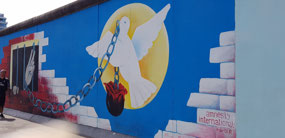
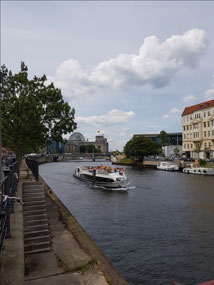
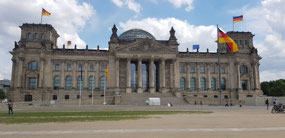
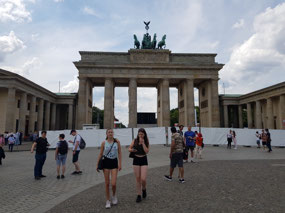
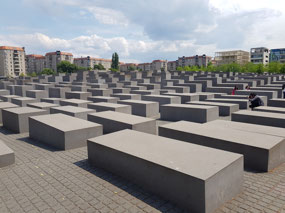
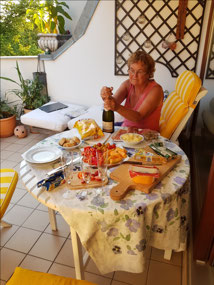







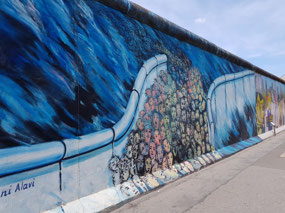
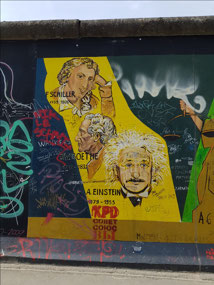
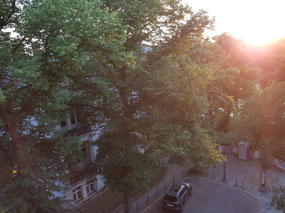
2025-05-22